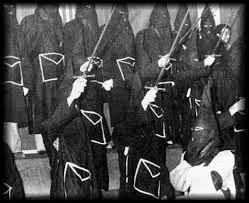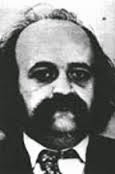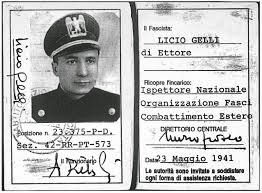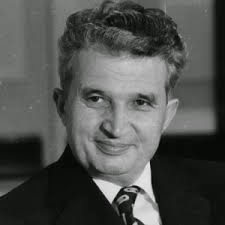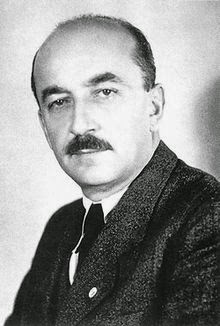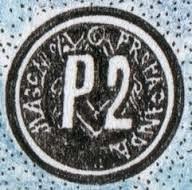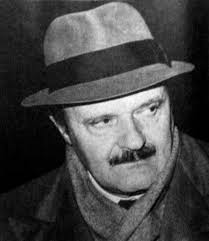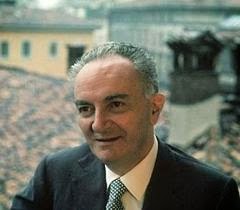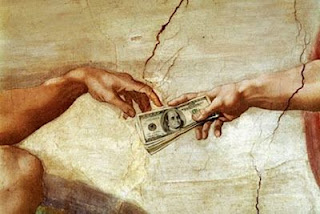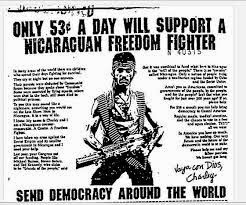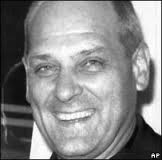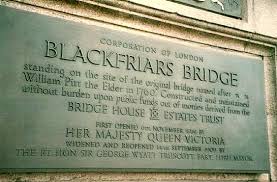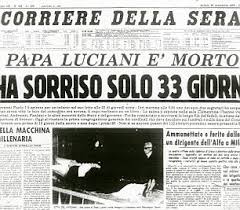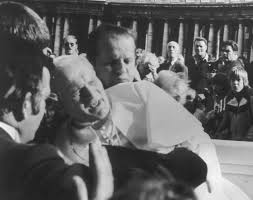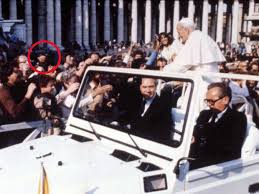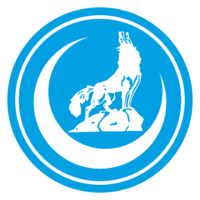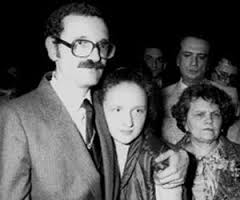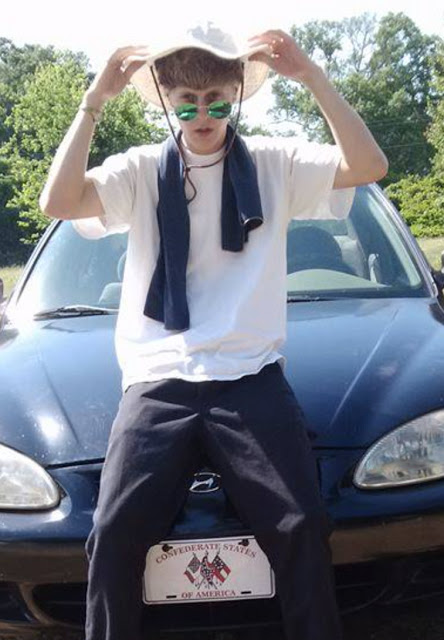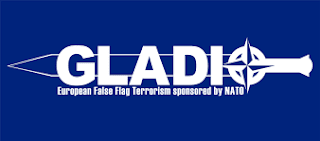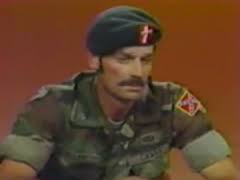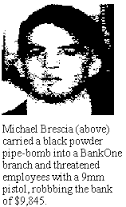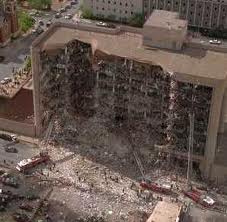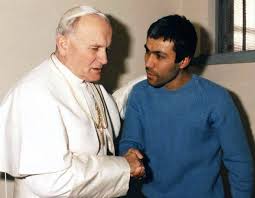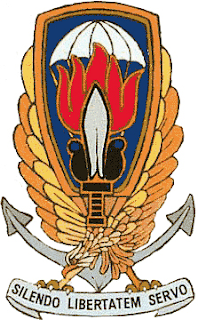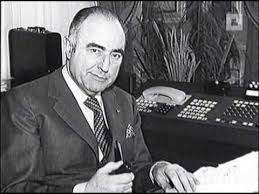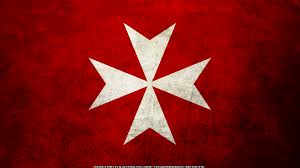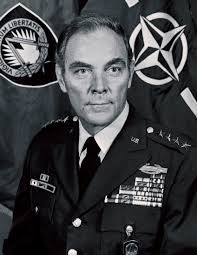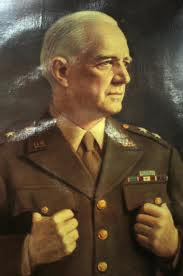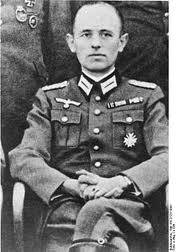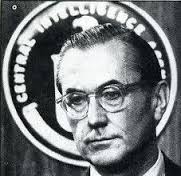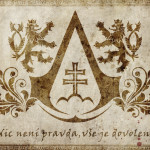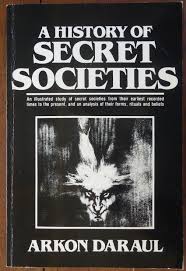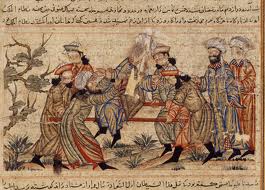Welcome to the eighth installment in my epic and ongoing examination of the notorious
Propaganda Due (commonly referred to as P2) Masonic lodge. For those of you just tuning in or trying to catch up, here is a brief rundown of what has already been addressed: With the
first part of this series I briefly outlined the controversies surrounding P2 and considered the background of its Venerable Grand Master, former
Blackshirt and
SS man
Licio Gelli. During the
second installment I moved along to the longstanding allegations that P2 had played a key role in a series of terror bombings that rocked Italy during a period known as the "
Years of Lead" as well the lodge's ties to the Lisbon-based terror network known as
Aginter Press.
Part three began to address what is commonly referred to as the "
Great Vatican banking scandal" or the "
Banco Ambrosiano affair" by considering the backgrounds of three of its main players, Bishop
Paul Marcinkus and financiers (and P2 initiates)
Michele Sindona and
Roberto Calvi. With the f
ourth installment I addressed the likelihood that a good portion of the missing funds from the banking scandal found their way to Central America and other P2 allies in Latin America where the money was used to fund various "
Contras" (*cough* death squads *cough*). The
fifth installment outlined the role the notorious
Rothschild banking dynasty played in the Vatican banking scandal as well as a series of armed robberies committed in Europe and the United States linked to various neo-fascist and Nazi groups and their possible tie to Banco Ambrosiano's collapse. Calvi's bizarre, ritualistic death was also addressed in that installment.
With
part six I moved along to a series of assassinations and attempted assassinations linked to P2, beginning with the
kidnap and murder of legendary Italian statesman
Aldo Moro as well as the sudden death of
Pope John Paul I. With the
seventh and most recent installment I moved along to the
attempted assassination of
Pope John Paul II, noting the involvement of the Turkish fascist terror network known as the
Grey Wolves in the shooting as well as the role the
Sovereign Military Order of Malta (SMOM, more commonly known as the Knights of Malta, a centuries old secret order originating with the
Knights Hospitallers and long linked to P2) had in spreading the longstanding allegations that the
KGB was behind the plot. Specifically, P2, SMOM and the Grey Wolves tried to frame the Bulgarian secret services (with assistance from the KGB, of course) for directing the assassination attempt. It is here that I shall pick up.
After addressing the role the Grey Wolves and the SMOM played in linking the KGB and Bulgaria to the assassination attempt in depth, it is now time to do the same for P2's efforts. As was noted in
part seven Pope John Paul II's shooter, the Grey Wolves assassin
Mehmet Ali Agca, initially claimed to be the lone shooter right after his arrest and only began to implicate Bulgaria a few days later. Agca's story changed dramatically during his initial incarceration in which he received a slew of VIPs from the Italian deep state. Let us now consider one of these visitors in particular:
"... Among the early callers on Agca's cell was Francesco Pazienza, a P2 lodge member connected with the disappearance of funds from Roberto Calvi's stricken Banco Ambrosiano. From 1979 to late 1981, Pazienza was a SISMI agent, important enough to become adjutant to the director, General Giuseppe Santovito, a Maltese Knight and another close acolyte of Licio Gelli. Santovito was later traced directly to attempts to expunge the Turkish Mafia presence from St. Peter's Square. Pazienza was a close associate of another P2 clansman... the neo-fascist Stefano Delle Chiaie.
"In September 1981, General Santovito resigned as general director of SISMI. His position was indefensible. He had been named as a P2 affiliate in the famous list discovered in Gelli's villa in Arezzo in the spring of that year. Santovito was the perfect example of the 'diseased culture' of the Italian secret services mentioned by crusading magistrate, Carlo Palermo. He was under suspicion for complicity in the bombing of Bologna railway station in August 1981. He was deeply involved in the accelerating crash of Banco Ambrosiano. He perverted the course of justice in the papal investigation. His close friends included the murdered General of the Carabinieri, Carlo Alberto Dalla Chiesa, the equivocal figure closely connected to the murder of Aldo Moro. Fearing a similar fate, he fled to the United States. He returned the following year, and was promptly arrested for involvement in the Bologna station bombing. He died in 1982, the unresolved charges hanging over his head.
"For all the official denials that Agca was expertly coached to denounce his six alleged Bulgarian accomplices, the compelling evidence to that effect is overwhelming. Agca received so many important visitors they were bound to excite attention in the confined quarters of prison. They certainly did not elude a fellow incarcerate, the famous Camorrista, Giovanni Pandico. He was the legendary 'super-computer,' considered the most important pentito in the history of the battle against the Mafia. He denounced practically a fill battalion of Neapolitan mobsters in 1983, based on his amazing total recall of all their names and infamies. Pandico confirmed that he frequently saw Francesco Pazienza in Agca's cell. Another VIP who paid his respects was General Giuseppe Santovito, DG (Direttore Generale) of SISMI. In the ancient manner of the Vatican, the prison chaplain, Father Pietro Santini, dutifully repeated these comings and goings to his Bishop, Msg. Marcello Morgante. He in turn sent regular reports to Archbishop Marcinkus, the brooding spider at the centre of the web in Rome.
"Pazienza spent hours with Agca, coaching him to memorise a dossier containing photos of the Bulgarian stooges. Agca rapidly absorbed the smallest details --uneven teeth, facial tics and blemishes --it seemed hypnotically. Three months later, six new suspects --five Bulgarians and a single Turk --were suddenly named by Judge Martella and arrested..."
(Gladio: NATO's Dagger at the Heart of Europe, Richard Cottrell, pgs. 270-271)
![]() |
| General Giuseppe Santovito, one of the most corrupt figures in the history of the Italian secret services, a truly Herculean accomplishment in and of itself |
There's a lot to take in here.
SISMI was Italy's chief foreign intelligence service. Its head, General Giuseppe Santovito, was already mentioned in
part six of this series in conjunction with the role he played in the bungled search for Aldo Moro that resulted in the statesman's death. Like Licio Gelli and another power P2 figure, Umberto Ortolani, Santovito was also a member of P2 and the Sovereign Military Order of Malta.
As for the General's close associate, fellow P2 initiate and possible Mehmet Ali Agca coach,
Francesco Pazienza, this individual also possessed a host of curious and far reaching connections. Consider:
"At about this time General Giuseppe Santovito, head of SISMI, Italy's military intelligence establishment, hired as his agency's Vatican and Palestinian specialist Francesco Pazienza. Born in 1946 at Taranto, southern Italy, into a staunchly Catholic family, Pazienza held a degree in 'deep-sea physiology.' Blessed with an idiomatic command of five languages, he knew a welter of international celebrities, including Aristotle Onassis, NATO commander-in-chief Alexander Haig, international swindler Robert Vesco, the PLO's Yasser Arafat and a range of Saudi princes. He also had excellent contacts in Latin America, particularly Argentina, where he claimed the nuncio, Archbishop Pio Laghi, was a close friend, as was the Vatican's permanent representative at the United Nations, Archbishop Giovanni Cheli."
(Their Kingdom Come, Robert Hutchison, pgs. 268-269)
![]() |
| P2 initiate Francesco Pazienza, who turns up in a host of intrigues |
Pazienza's ties to the notorious financier
Robert Vesco are most interesting. Vesco managed his own shadow banking empire with extensive ties to both organized crime and various intelligence agencies. During the 1970s he became involved with a host of Caribbean and Central American nations, many of the same ones P2 would also have dealings with at some point. In the late 1960s and very early 1970s Vesco was a major campaign contributor to the
Richard Nixon and developed extensive ties therein. This was at the same time the Michele Sindona was also investing heavily in Nixon, as was noted in
part three. Thus Pazienza, a P2 initiate, provides another compelling hint at links between the shadow banking empires of Vesco and Sindona (and by default, P2).
As was noted in the
first installment,
Alexander Haig was one of the high ranking US officials whom gave Licio Gelli his blessing in seizing P2 during its formative years. And like Gelli, General Guiseppe Santovito (Pazienza's patron in the SISMI), Umberto Ortolani and other powerful P2 figures, Haig was a member of the Sovereign Military Order of Malta. But moving along.
![]() |
| General Alexander Haig, one of several key Knights of Malta members who turn up in the P2 story |
So, can the "Bulgarian Connection" by totally dismissed as disinformation and be discarded?
Not by a long shot. In point of fact, it is potentially the most disturbing aspect of the
St. Peter's Square shooting and for good reason: When one looks deep enough in to the Bulgarian Connection one is confronted by a cesspool of drugs, arms and international terrorism that stretched far beyond the ideological barriers of the
Cold War.
To understand the Bulgarian connection, we must first go back to the late 1960s, when the
Federal Bureau of Narcotics (FBN, one of the predecessors to the
DEA) first began to extensively investigate narcotics trafficking in Turkey. The FBN agent who made the most headway in this endeavor was a human being named Richard Salmi. What he uncovered should have been one of the biggest scandals of the Cold War for both West and East.
"According to Salmi, Turkey's underworld was comprised of ten families, whose biggest criminal enterprise was smuggling opium and morphine base out of the country, and arms back in. The arms were sold to the Kurds, a disenfranchised minority group in Eastern Turkey, fighting insurgent wars in Iran and Iraq. Narcotics going out of the country were often hidden in the trucks and cargo of Turkish workers going to Germany. One group of smugglers set up the Overland Company specifically to move morphine base to Europe and return with weapons. 'It was an Overland truck that was carrying the drugs in the Watermelon case,; Salmi says, 'but we didn't learn about the guns until a few weeks later, when another Overland truck packed with weapons, was seized in Austria on its way back to Turkey. So by 1967 there was a proven correlation between arms and drug smuggling. We knew the Turks were involved, how the payoffs were made, and the routes they used through Bulgaria and Hungary.'
"The involvement of East Europeans in the drug trade and the movement of guns to the Kurds were issues of tremendous interest to the CIA station in Turkey. As a way of exploiting the situation for its own purposes, the CIA convinced the FBN that a surge in terrorism in Turkey was not the result of internal political unrest, but of the KGB's control of the Bulgarian drug trade. The FBN was glad to assist the CIA by providing the spy agency with Interpol reports identifying drug traffic transit ports in Bulgaria. The CIA also professed to share an interest with the FBN in making a case on the Kulecki and Cil clans, the dominate alliance in the guns-for-drugs trade between Turkey and Bulgaria. But both families were very well protected. Mehmet Kulecki, owner of the Kennedy Hotel in Istanbul, was arrested in 1965 for possession of 147 kilograms of opium, but before the case got to court, the opium was exchanged for river mud and Kulecki was set free. Huseyin Cil, the owner of several hotels on the Syrian border, was so well protected that he actually got away with murder. But daring Dick Salmi decided to go after them anyway."
(The Strength of the Wolf, Douglas Valentine, pgs. 402-403)
![]() |
| Turkey has long been one of the cornerstones of the international heroin market |
Salmi managed to bust Cil in 1967 (with the assistance of the
Air Force Office of Special Investigations [AFOSI, which has been involved in some curious happenings, as I noted before
here and
here], the CIA, and the CIA trained Turkish secret police) but it was all for naught: Cil was later found not guilty in court. Salmi blamed this set back on the "corruption" of the Turkish state. By the early 1970s he was working for the
Bureau of Narcotics and Dangerous Drugs (BNDD, another predecessor to the DEA) once again launching an attack on the Bulgarian Connection, and again with the alleged assistance of the CIA.
"The BNDD's real enforcement success came as a result of the friendship, forged in 1968, between Salmi and the aftermentioned Dewey Clarridge, CIA liaison to the Counter-Guerrilla Center with its terrorist Grey Wolves unit. As Salmi noted, he and Clarridge established personal trust...
"In 1971, CIA headquarters directed Clarridge to officially join the war on drugs. 'With Dewey it was informal,' Salmi adds. 'He didn't know what to say in his reports, so I told him.' Salmi provided information on major crime families, trends, and analysis. In exchange, Clarridge gave Salmi a list of airstrips, shipping companies, and political figures the CIA knew to be involved in drug trafficking. Clarridge was interested in how arms traffickers were smuggling guns to the ever-rebellious Kurds in Western Turkey. Salmi knew that the gun runners worked with Turkish, Iranian, Syrian and Jordanian traffickers, and he knew which Israelis (ever instigating trouble in Muslim nations) were facilitating shipments to Iran to selected Kurdish insurgents. Using the information gathered and provided by Salmi, Clarridge shined at Langley.
"In Istanbul, Clarridge and Salmi discovered some startling information about Bulgaria. Through a defector, Clarridge learned that the Bulgarian Secret Service, at the behest of the KGB, was facilitating the gun and drug smuggling activities of Turkish crime families through a Bulgarian tourist agency known as Kintex. Salmi obtained further information about complicit Bulgarian spies from his Interpol contacts. Clarridge helped Salmi investigate and together they were able to chart the flow of Turkish drugs west, through Bulgaria to France, Germany, Italy and east into Afghanistan and Iran. Nothing, however, came of their efforts to implicate the Bulgarians. The archangels in Washington had other priorities and, in November 1971, Customs and BNDD officials traveled to Sofia and began to instruct Bulgarian customs officials in American drug interdiction techniques. The Kintex scandal was swept under the carpet as part of the investigation."
(The Strength of the Pack, Douglas Valentine, pgs. 130-131)
![]() |
| if its corporate headquarters are any indication, Kintex is still doing well for itself |
Thus Salmi's investigation into the Bulgarian connection was once again stonewalled. Officially the CIA was concerned by these developments and had even attempted to aid the FBN/BNDD, or so Salmi believed. But
Dewey Clarridge's honesty should have probably been subjected to more scrutiny, as we shall see in a moment.
It is interesting to note at this point that the CIA's station chief in Turkey from 1974 to 1977, Paul B. Henze, would go on to become one of the most prominent proponents of the KGB and Bulgarian conspiracy theories surrounding the attempted assassination of Pope John Paul II. He seems to have succeeded Clarridge as station chief in Turkey and his later involvement in the narrative surrounding the events in St. Peter's Square is most curious:
"Drenched by decades of unremitting propaganda, the well-fertilised public will believe the worst of the Soviets and their allies overpowered the uncritical media. Soon the Soviet plot acquired the status of established fact, helped along by Paul Henze, and the professional CIA whitewasher Claire Sterling. She worked out of the CIA station in Rome, posing as a reporter, the classic espionage cloak. Her 1981 book, The Terror Network, which blamed the Soviets for causing all terrorist violence in the world, uncannily chimed with the forthcoming attack on the Pope. Retrospectively, it looks suspiciously like an overture. As Henze was the CIA's point man with Turkish intelligence MIT, he was naturally familiar with every nut and bolt of the narcotics and arms carousel. He was the chess master who knew the moves of every Turkish gangster roaming Europe..."
(Gladio: NATO's Dagger at the Heart of Europe, Richard Cottrell, pg. 279)
![]() |
| Henze |
And as for Dewey Clarridge and his KGB-backed Bulgarian connection running through the Sofia-based company Kintex, neither was seemingly what they appeared to be on the surface:
"The CIA station chief in Rome at the time of the papal shooting was Duane Dewey Clarridge, who had served with the Agency in Turkey in the early and mid-1970s when armed bands of Grey Wolves unleashed a wave of bombings and political assassinations that culminated in a military coup at the turn of the decade. Disclosures by Turkish human-rights groups indicate that during this period, the Grey Wolves worked in tandem with the Turkish army's Counter-Guerrilla Organization, which functioned as the Turkish branch of the CIA's multinational 'stay behind' program.
"At the same time, members of the Grey Wolves were immersed in the international drug trade. Serving as couriers for the Turkish Mafia, they criss-crossed the infamous smugglers' route passing through Bulgaria, which served as a transit point for sizable shipments of arms and heroin. An inquiry by Italian magistrates disclosed that large quantities of sophisticated NATO weaponry --including machine guns, Leopold tanks, and U.S,-built Cobra assault helicopters --were smuggled from Western Europe to countries in the Middle East during the 1970s and early 1980s; deliveries were often made in exchange for consignments of heroin that filtered back, courtesy of the Grey Wolves and other smugglers, to northern Italy, where the drugs were received by Mafia middlemen and transported to North America. Turkish morphine formed the basis of the infamous 'pizza connection' which flooded the United States with high grade heroin for years.
"The bristling contraband operation that traveled Bulgaria was a magnet for secret-service agents on both sides of the Cold War divide. Crucial, in this regard, was the role of Kintex, a Sophia-based, state-controlled import-export firm that played a pivotal role in the arms trade. Kintex was riddled with Bulgarian and Soviet spies --a fact that encouraged speculation that the KGB and its Bulgarian proxies were behind the 1981 papal shooting. But Western intelligence also had its hooks into the Bulgarian smuggling scene, as evidenced by the CIA's use of Kintex to channel weapons to the Nicaraguan Contras in the early 1980s. Although the CIA's link to the arms-for-drugs trade in Bulgaria was widely known in intelligence circles, Congress preferred to emphasize the testimony of former CIA agents and right-wing conspiracy theorists, who alleged the Bulgarian secret service and the Soviet KGB had plotted to kill the pope. It proved to be one of the most efficacious disinformation schemes hatched during the Reagan era, reinforcing the notion that the USSR was an 'Evil Empire' while deflecting attention from extensive --and potentially embarrassing --ties between U.S. intelligence and Turkish neo-Nazis."
(The Beast Reawakens, Martin A. Lee, pgs. 202-203n)
![]() |
| Duane "Dewey" Clarridge has long been alleged to have been a key player in the Iran-Contra affair (of which P2 was involved in up to its eyeballs, as has been noted throughout this series) and in recent years has taken to managing his own private intelligence network |
To recap: Turkish CIA station chief Dewey Clarridge was allegedly concerned that the Turkish Mafia was aiding the KGB via an arms-for-drugs smugglers network running through Bulgaria and centered on the Kintex firm. His successor, Paul B, Henze, seems to have shared these fears and used it as the basis for the KGB plot allegations surrounding Pope John Paul II's attempted assassination. And yet Clarridge was also the liaison to the Turkish
Counter-Guerrilla unit that directed the Grey Wolves terror network. The Grey Wolves also worked closely with the Turkish Mafia in transporting heroin to Italy via... Bulgaria.
And it just so happened that Clarridge was the CIA station chief in Rome when Pope John Paul II was almost murdered by Mehmet Ali Agca, a member of the Grey Wolves. The same Grey Wolves who operated under the Counter-Guerrilla unit that Clarridge had extensive ties to.
Should it come as a surprise then that even Pope John Paul II discounted the allegations concerning the KGB and the Bulgarian secret service?
As incredible as all this may seem, two independent investigators working in the 1980s --one a Turkish journalist, the other an Italian judge --confirmed that a vast drugs and arms smuggling network existed that brought together agents of both West and Eastern intelligence services and which was centered around Turkey, Bulgaria and Italy:
"As the 1980s opened Judge Carlo Palermo --a former Italian MP, bustling lawyer and painstaking magistrate --was quietly sifting through a stack of reports at his chambers in the mountain city of Trento. He was searching for clues to the Sicilian Mafia's heroin-running activities in collusion with drug cartels in Eastern Europe. Powerful incriminating evidence has started to filter from the wreckage of Michele Sindona's banking and money laundering empire. About the same time, Ugur Mumcu --fearless investigator for the Istanbul daily Cumhuriyet --established in 1983 the facts of the vast east-west arms and drug trafficking carousel, passing through a niche of the Soviet bloc:
"And the interesting thing is that the weapons smuggled in Bulgaria are weapons produced in NATO countries. Don't the Bulgarian police know or see how all these arms from NATO nations clandestinely enter a Warsaw Pact member nation? They know --and see.
"Ugur Mumcu would pay for this and other revelations surrounding the Turkish deep state, including the attack on the Pope, with his life. He was assassinated by a car bomb outside his home on 24th January 1993. Judge Palermo joined the ranks of diligent magistrates who took a great personal risk in exposing many dangerous secrets harboured by the Italian deep state. He almost paid the same price, narrowly escaping assassination in a booby-trapped car. Palermo's detective work confirmed a network which linked several eastern countries, including Bulgaria and Turkey, operating through a major junction in Italy. But, unwittingly at the time, he tripped over an even bigger stone: the sinews linking the narcotics racket, the massive NATO arms scam and the involvement of western intelligence in all of those activities.
"On 24th November 1983, Palermo issued no less than two hundred arrest warrants in the great arms and drugs merry-go-round. In a later memoir he wrote: 'I was [informed] by Milan's Finance Office about the role carried out by an important Islamic credit institution, the Bank of Credit and Commerce International, a bank founded by the Pakistani mafia operating all around the world, entailed to the drugs and weapons traffic, and even to terrorism. That report also included some inculpating elements among those high level complications, and some of our mysteries: that of Banco Amrosiano, the P2, Calvi's suicide in London, that of our deviated secret services, the most recent that of the attempt to kill the Pope...'
(Gladio: NATO's Dagger at the Heart of Europe, Richard Cottrell, pg. 274)
The
Bank of Credit and Commerce International (BCCI) is yet another disgraced and defunct financial institution that was implicated in drug and arms trafficking. Naturally it was also a key player in supplying arms to the Central American Contras as well as the
Afghan Mujahideen, both of whom benefited tremendously from the Bulgarian Connection. And of course BCCI has been extensively linked to the
US intelligence community. Historian
Peter Dale Scott believed that BCCI and the various banks associated with P2 formed part of an international shadow banking system used by the US intelligence community for various black ops.
Scott noted:
"It is clear that Jews were, like many other minorities, a constituent in the global drug connection. More importantly, they were an important part of the financial infrastructure of that connection – but even at this level they did not operate alone. The global drug connection combined Jewish banks in Florida and Switzerland with those of Teochew, Fujian, and Hokkien Chinese in Southeast Asia and Hong Kong, the Muslims of Bank Intra and later BCCI in the Middle East, and furthermore Italian banks like those of Michele Sindona and Roberto Calvi, both members of the intelligence-linked Masonic Lodge P-2, and both murdered after their banks failed from mafia involvement. It is my impression that none of these ethnic minority elements ever surpassed in power the dominant role of figures from the mainstream, like [William] Donovan and [Paul] Helliwell."
Scott charges that this global network was the brainchild of
William "Wild Bill" Donovan and
Paul Helliwell, and dated back to the immediate aftermath of the Second World War. Donovan was the founder and head of the
OSS, the predecessor to the CIA. Donovan was also, like Licio Gelli and several other powerful figures already considered in this series (General Giuseppe Santovito, Umberto Ortolani, Alexander Haig, etc), a member of the Sovereign Military Order of Malta.
![]() |
| Knight of Malta William "Wild Bill" Donovan |
Paul Helliwell was also an OSS veteran. Specifically, he was part of a far right clique within the OSS sometimes referred to as the "China cowboys" due the operations they carried out in China prior to the Communist takeover that drove out the
Kuomintang (KMT) regime. The KMT would set itself up in Taiwan as the ruling party and would wage a decades-spanning and CIA-backed covert war against mainland China. Ample funds for these operations were provided by drug money. The KMT and these "China hands" would go on to play extensive roles in various CIA-backed "regime changes" during the Cold War. There first major project involved the Central America nation of Guatemala.
"In 1953-54 the CIA drew on old China hands with exposure to KMT traffic (Chennault, Willauer, William Pawley, Howard Hunt) to set up the overthrow of the Arbenz government in Guatemala, an operation which at least contemplated the use of 'Puerto Rican and Cuban gangsters.' As part of this operation, we see CIA officer Howard Hunt, a veteran with friend Lucien Conein and Conein's friend WerBell of OSS operations in China under Helliwell, helping in 1954 to set up what would eventually become the Latin American branch of the KMT-backed World Anti-Communist League..."
(The Great Heroin Coup, Henrik Kruger and Peter Dale Scott, pg. 16)
The
World Anti-Communist League (WACL) was a powerful international body that brought together a curious mixture of US military and intelligence officers, international arms and drug traffickers, various third world dictators, religious extremists of various stripes and the inevitable unreconstructed Nazi and fascist war criminals. As was noted in
part two of this series, P2 had ties with this network.
It is interesting to note that the WACL had its own Bulgarian branch largely comprised of former Nazi collaborators who had fled their homeland after the Communist takeover. The head of the Bulgarian branch was the enigmatic figure of Spas Raikin. It should come as little surprise to the reader that Mr. Raikin seems to have had associates involved in drug trafficking:
"Peter Dale Scott writes: 'Spas T. Raikin was also the Secretary-General of the American Friends of the Anti-Bolshevik Bloc of Nations, a small but vigorous group of right-wing revanchiste Eastern Europeans in direct touch with the FBI... and Army intelligence – and also with the Gehlen spy organization in West Germany; the Kuomintang in Taiwan, the mother of Madame Ndu, right-wing Cubans like Oswald's DRE contact Carlos Baringuier, and other elements of a shadowy "World Anti-Communist League." This WACL had contacts with U.S. anti-Communists in New Orleans, in the building with the Camp St. address... used by Oswald on his pro-Castro literature, and also by the CIA's Cuban Revolutionary Council of which Bringuier had once been press secretary. As I have indicated in my book, The War Conspiracy, Mr. Raikin's personal correspondents in Taiwan (the Asian People's Anti-Communist League) were intelligence agents involved in the Kuomintang's narcotics traffic – a fact dramatically illustrated by the 1971 arrest in Paris of the Chief Laotian Delegate to the APACL, whose suitcase contained 60 kilos of high-great heroin, which have been worth $13.5 billion in the streets of New York...'... "
(A Secret Order, H.P. Albarelli Jr., pg. 440n)
![]() |
| a young Spas Raikin |
As the above indicates, Raikin also appears in the saga leading up to the
assassination of JFK, as I noted before
here. But moving along.
Let us return now to Judge Palermo's investigation. Palermo seems to have concluded that P2 was one of the key players behind this Bulgarian Connection that spanned East and West:
"As the story unravelled, it became inseparable from the hard evidence appearing from Judge Palermo's stunning paper trail. Large quantities of sophisticated NATO weaponry, including tanks and American-made Cobra helicopters, were routinely purloined from the Alliance and smuggled around the world throughout the 1970s and early 1980s. It was the world's most powerful clandestine arms trafficking organisation, eclipsing anything previously known. Moreover, it ignored the political barriers which divided Europe. I was told by several contacts, while involved in Bulgarian matters, that American accents were heard as cargoes were shifted between planes at the capital city's rundown airport. Anonymous-looking, white-painted aircraft usually recognized as part of the CIA's private fleet were said to be regular visitors. On 24th November 1982, Judge Palermo issued arrest warrants against two hundred suspects of a dozen nationalities implicated in the vast weapons and narcotics cycle 'which sent heroin to the West and weapons to the East... dominating this traffic in both directions from Turkey and the Near East to all of Western Europe and the United States.' Palermo named Bekir Celenk as the leading figure on his list. The dogged magistrate put his finger on the real Bulgarian Connection, the overwhelming quantities of arms and drugs waved through Bulgaria under the unseeing eyes, as Ugur Mumcu described them, of the Bulgarian customs agents.
"Italy was the hub. The heroin which paid for the arms was then marketed by American and European crime syndicates, most of that siphoned through Sindona's and Calvi's banks or the ones they controlled, including the Vatican's Institute of Religious Works. Propaganda Due brought together all the necessary political contacts and infrastructure needed to control the operation. More nuts and bolts were supplied by the usual services of Stibam International Transport. The Syrian (or Armenian) Henri Arsan, who ran the outfit, would sometimes boast he worked undercover for the US Drug Enforcement Administration. This was a rather provocative indication of his real connections. Arsan, alternatively Arsanaylan, was known as the 'playboy Mafioso,' out of his addiction to gaudy clothes and flamboyant gold jewelry. The playboy's big friend in the Turkish Mafia was none other than Celenk, Palermo's chief smuggling suspect and the baba named in the plot to kill the Pope. Stibam's offices in Milan were conveniently situated right above Roberto Calvi's palatial suite in the Banco Ambrosiano building. But Arsan held other keys, as a confidante of Licio Gelli: namely, the crucial P2 connection."
(Gladio: NATO's Dagger at the Heart of Europe, Richard Cottrell, pgs. 277-278)
![]() |
| Turkish Mafioso Bekir Celenk |
The above-mentioned Bekir Celenk was a member of the Turkish Mafia with close ties to the Grey Wolves and who was also linked to Mehmet Ali Agca and the attempted assassination of John Paul II. More will be said on the forces behind the Grey Wolves in a moment, but for now its worth noting that Licio Gelli clearly had the political contacts to manage, or at least play a key role in, an arms-for-drugs smuggling network that spanned the Eastern and Western blocs during the Cold War. The great Philip Willan notes:
"... Gelli's address book, confiscated from his office at Castiglion Fibocchi, contains the name of another Loris Scricciolo, a socialist Member of Parliament and a second cousin of the Red Brigades terrorist of the same name. Also listed was Piero Scricciolo, a busisness man living in Arezzo and Luigi Scricciolo's uncle. Both had been members of P2. Moreover, Luigi Scricciolo, the trade unionist who put the Red Brigades in touch with the Bulgarian secret services, was in regular contact with the American embassy in Rome, calling on officials there almost every week. It would therefore appear that the Scricciolo family could provide a potential bridge between P2 and the CIA on the one hand and the Red Brigades on the order..."
(Puppetmasters, Philip Willan, pg. 338)
![]() |
| Gelli |
In addition to P2 member Luigi Scricciolo apparently having contacts with the Bulgarian secret services, another P2 (and Sovereign Military Order of Malta) initiate seems to have had dealings with the Bulgarian smugglers route as well. Richard Cottrell notes: "Judge Palermo named [General Giuseppe] Santovito as a leading figure in the East-West arms and dope carousel..." (
Gladio: NATO's Dagger at the Heart of Europe, pg. 277, n51).
But let us now step back from the Bulgarian Connection for now. Its implications are incredible, but can not be properly addressed until the next installment where the actual puppetmasters behind P2 will be addressed. For now, three interesting claims concerning the actual plotters who carried out the attempted assassination shall be considered. The first comes from
Abdullah Catli, the Grey Wolves heavyweight who had extensive dealings with Mehmet Ali Agca and was addressed briefly in
part seven of this series.
Martin A. Lee reports:
"Abdullah Catli, the high-ranking Grey Wolves member who gave Ali Agca the gun that was used to shoot the pontiff, later stated under oath in a Roman court that he had been approached by the West German BND spy organization, which allegedly promised him a large sum of money if he implicated the Bulgarians and the Soviets in the papal plot..."
(The Beast Reawakens, Martin A. Lee, pg. 202n)
![]() |
| Catli |
Catli's claim in this instance is highly plausible. As noted in
part seven, the
BND played an extensive role in establishing the false Bulgarian/KGB plot via the Turkish BND asset Musa Sedar Celebi who began making such claims days after the shooting. As noted there, it is possible Celebi's handler was
Ruzi Nazar, a Uzbek who became involved with the SS in the Ukraine during WWII. After WWII he made use of the "
Ratlines," which fellow SS man Licio Gelli was deeply involved with (as detailed in
part one). Nazar also had ties to the BND and was operating out of Germany during this time.
The BND, West Germany's intelligence service, had its origins in the
Gehlen Organization. The Org, as it was sometimes known, had been Nazi Germany's Eastern European and Russia intelligence network and was directed by General
Reinhard Gehlen. After the war Gehlen and his network were recruited wholesale by the US intelligence community despite many lingering questions about the network's loyalty (it collaborated with agents of both West and Eastern intelligence services regularly). As noted above, the Org also had extensive dealings with the World Anti-Communist League, which had ties to both P2 and remnants of Bulgaria's Nazi Quislings, most notably the infamous Spas Raikin. And naturally, Reinhard Gehlen was himself a member of the Sovereign Military Order of Malta.
![]() |
| Maltese Knight Reinhard Gehlen |
As for the final two claims, they come from an individual close to Pope John Paul II and former affiliates of P2, all of whom seem convinced that the lodge was deeply involved in the assassination plot. Richard Cottrell remarks:
"Juan Arias --the Spanish philosopher and close intimate of John Paul --observed that 'the fact that the P2 in some way, directly or indirectly, participated in the papal attempt has always been a taboo that everyone wanted to avoid.' This is one of the most significant and revealing assertions in connection with St. Petersgate. Coming from a trusted confidant, it demonstrated the Pope knew exactly whose hand was on the trigger. As much had been suspected by General Ambrogio Viviani, chief of SISMI's counter-intelligence division (1970-74). Before he turned pentito, Viviani was an affiliate of P2. Speaking to the Turin daily La Stampa in 1994, he suggested that to 'analyse the assassination of the century it is necessary to write the facts of what was happening by then in Poland, Agca's movements and what was happening in Italy...'
"Vanni Nistico, formerly the press officer of the Italian socialist party, and another P2 affiliate, circulated an odd tale around Rome that Licio Gelli once showed him some photographs of John Paul relaxing au naturel at his swimming pool at the Castel Gandolfo summer papal retreat. According to Nistico, Gelli commented enigmatically: 'If it's possible to take these pictures of the Pope, imagine how easy it is to shoot him.' Put another way, as Nistico obviously suspected, how easy it was for Gelli --whose personal rake from the Sindona scams has been estimated at $500 million --to pay his papal informers to snatch such intimate moments. These revealing holiday snaps, if anything more than apocryphal, confirm Judge Palermo's critique of 'our deviated secret service.' "
(Gladio: NATO's Dagger at the Heart of Europe, Richard Cottrell, pgs. 278-279)
Needless to say, it seems quite compelling that P2 was involved in the attempt on John Paul II's life in some fashion. At least as compelling as the evidence that they were involved in the sudden death of his predecessor (discussed in
part six), which has been widely suspected for years now. The links P2 had to the attempt on John Paul II have not received anywhere the kind of coverage that the links to John Paul I's sudden death have received by the lodge's critics in no small part due to the presence of Eastern European intelligence services in this plot.
These implications are of course quite startling and have been used by hacks such as
Stephen Knight to pimp the good old Masonic-Communist-Judaic One World Government conspiracy theories that have been circulating for decades now and constitute one of the chief fever dreams of the American conspiratorial right. Hence, serious researchers have likely been hesitant to follow such trails so as to maintain credibility.
In the next installment these ties and their implications shall be considered in depth as well as the actual controllers of P2. Stay tuned.
